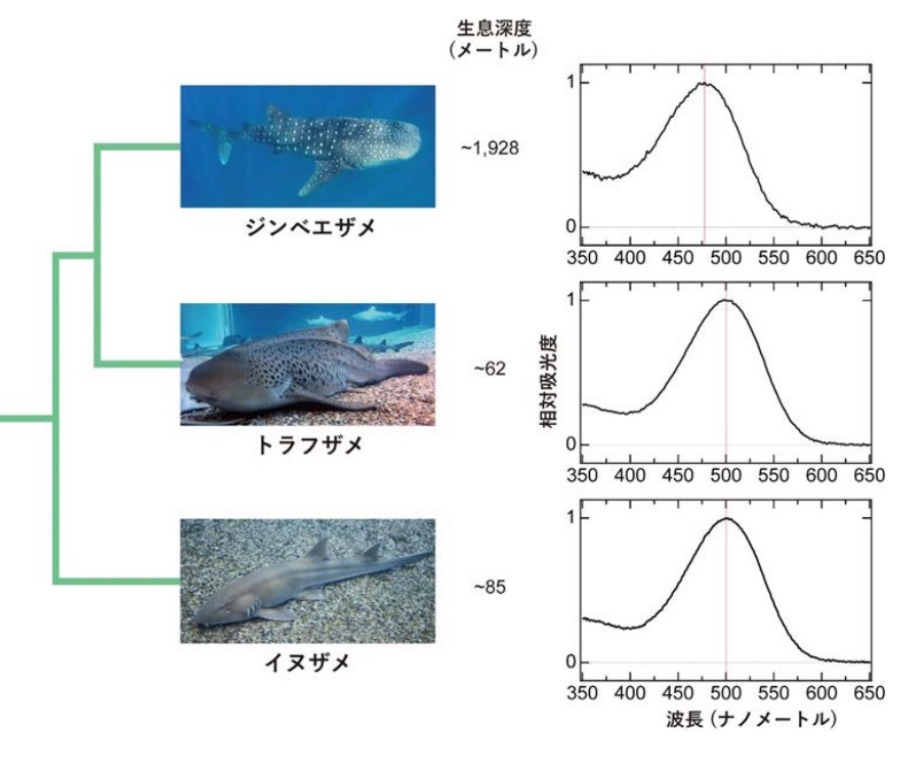- Home
- Okinawa Churashima Foundation Research Institute
- Studies of Marine Animals
- Research activity report
- Scientific paper published on the genetic research advances our understanding of whale shark vision

Research on marine organisms
Scientific paper published on the genetic research advances our understanding of whale shark vision
Whale sharks filter feed for zooplankton at the ocean's surface. Researchers have tracked and logged whale shark movements with data logging devices, and found that whale sharks also dive down to the dark deep sea. As whale sharks live in both well-lit surface waters and dark depths, how do their eyes manage this challenge?
In the eyes of many vertebrates, light is received in the retina by five types of opsin (light-sensitive receptor proteins). As far back as primitive vertebrates, these receptors have allowed low-light vision, daylight vision and color vision. Researchers have studied the eyes of various vertebrates to understand which wavelengths / colors particular opsins react to. However, research on opsins in sharks is very limited.
Researchers from Okinawa Churaumi Aquarium collaborated with research teams led by Professor Shigehiro Kuraku of Research Organization of Information and Systems National Institute of Genetics (Team leader of RIKEN) and Professor Mitsumasa Koyanagi of Osaka Metropolitan University, to research how genetics influences the vision of whale sharks. The researchers found that whale sharks have genes that produce retinal rhodopsin that is sensitive to long wavelengths (red end of the spectrum) in addition to rhodopsins that enable bright light and low-light vision. Using DNA information, the research team synthesized retinal rhodopsin proteins that react to low light to investigate their effective absorption of different wavelengths. By using spectroscopy to measure the wavelengths of light, the results showed that compared to other shark species, whale shark rhodopsin was found to be the most efficient receptor of the blue light that reaches the deep sea. Researchers also found that the whale shark rhodopsin was not affected by the cold temperatures that occur in the deep sea.
The research suggests that whale shark vision has adapted to life in the deep sea by being sensitive to the dim bluish light. By using DNA information to artificially synthesize proteins researchers could make new scientific discoveries without sacrificing the lives of precious animals.
Authors
Yamaguchi, K., Koyanagi, M., Sato, K., Terakita, A. and Kuraku, S. (Bold letters: Staff members of Okinawa Churashima Foundation)
Title
Whale shark rhodopsin adapted to deep-sea lifestyle by a substitution associated with human disease.
Journal
Proceedings of the National Academy of Sciences
link
https://doi.org/10.1073/pnas.2220728120

Image: Characteristics of rhodopsin in whale sharks and related shark species. The left image shows three shark species and their lineage. The right image shows the absorption spectrum of synthesized rhodopsin. Zebra sharks and brownbanded bamboo sharks live in shallow waters. Their eyes easily absorb light at a wavelength of 500 nanometers. Whale sharks have evolved to efficiently absorb shorter wavelengths of light (480 nanometers) which is the bluer light that reaches the deep sea.
This adaptation is known as blueshift.
Copyright (c) 2015 Okinawa Churashima Foundation. All right reserved.




























